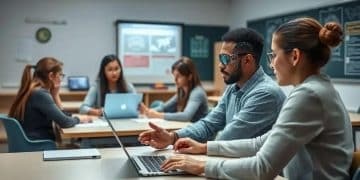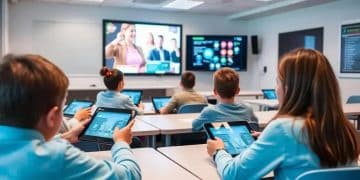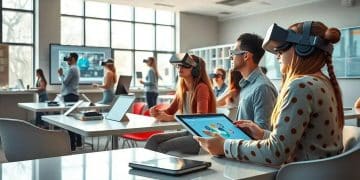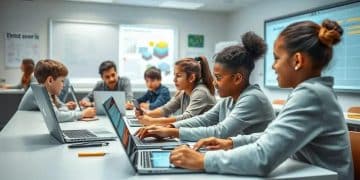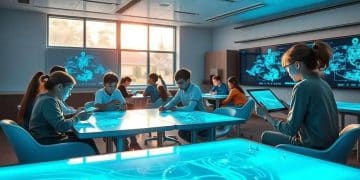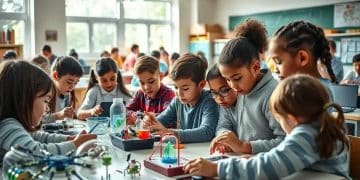Accommodations for neurodiverse students: unlocking potential

Enhancing learning environments for neurodiverse students involves flexible seating, sensory spaces, and utilizing technology to create inclusive and supportive classrooms that cater to diverse learning needs.
Accommodations for neurodiverse students are essential for creating inclusive learning spaces. Have you considered how these adjustments can truly enhance educational outcomes? Let’s dive in and explore the impact they can have.
Understanding neurodiversity in education
Understanding neurodiversity in education is crucial for creating effective learning environments. Neurodiversity refers to the variety of ways in which the human brain can function and process information. Recognizing this diversity allows educators to better support all students.
The importance of neurodiversity
Embracing neurodiversity promotes inclusiveness and fairness in education. It helps in acknowledging that every student learns differently. This understanding encourages tailored teaching methods that can meet the varied needs of learners.
Common neurodiverse conditions
- Autism Spectrum Disorder (ASD)
- Attention Deficit Hyperactivity Disorder (ADHD)
- Dyslexia and other learning disabilities
- Obsessive-Compulsive Disorder (OCD)
Each condition presents unique challenges and strengths. For instance, while students with ADHD may struggle with attention, they often bring creativity and energy to their learning. It’s essential to view these differences as strengths, not weaknesses.
Benefits of understanding neurodiversity in education
When educators grasp the concept of neurodiversity, they can:
- Develop individualized teaching strategies that cater to diverse learning needs.
- Foster an understanding of differences among students, promoting empathy and cooperation.
- Enhance classroom dynamics by including all types of learners.
Ultimately, recognizing the value in neurodiverse learners enriches the academic experience for everyone, creating a more inclusive and effective educational system. Through understanding and support, we can unlock the potential of all students.
Types of accommodations for neurodiverse students
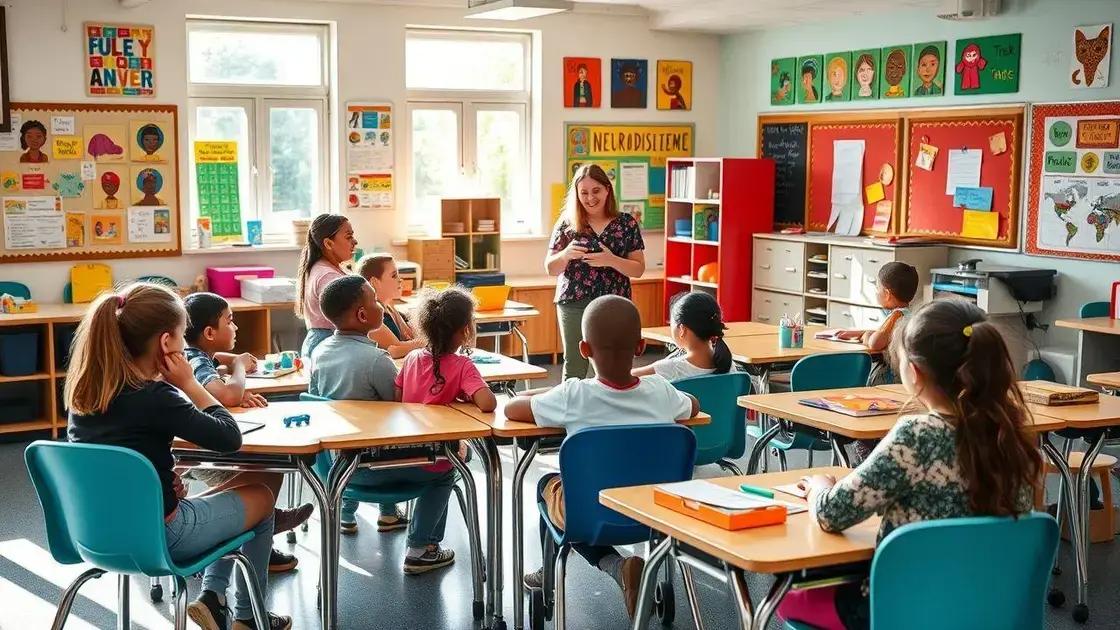
Understanding the different types of accommodations for neurodiverse students is vital for creating an effective learning environment. Each student has unique needs that can be supported through tailored strategies.
Academic accommodations
These accommodations help neurodiverse students succeed in their learning tasks. They may include:
- Extended time on tests and assignments
- Alternative formats for assignments, such as audio or visual presentations
- Access to note-taking aids and technology
These adjustments allow students to demonstrate their knowledge without being hindered by their challenges. It’s important to personalize these strategies for each student, based on their specific needs.
Environmental accommodations
A classroom’s environment can greatly affect learning. Providing a comfortable setting includes:
- Quiet areas for focused work
- Flexible seating options to suit individual preferences
- Visual aids and clear signage to assist navigation
Such changes can minimize distractions and help neurodiverse students feel more at ease, enhancing their ability to concentrate on their studies.
Behavioral accommodations
Behavioral strategies are essential for fostering positive behavior. These may involve:
- Clear expectations and routines
- Positive reinforcement for good behavior
- Access to calming tools or strategies when feeling overwhelmed
Understanding each student’s triggers can help teachers implement these behavioral supports effectively, promoting a harmonious classroom atmosphere.
By integrating various types of accommodations, educators can create a supportive learning environment. This approach not only aids neurodiverse students but elevates the entire classroom experience.
Implementing effective strategies in the classroom
Implementing effective strategies in the classroom is essential for supporting neurodiverse students. These methods can help create a welcoming environment where all learners can thrive. Different tactics can cater to various learning styles and needs.
Personalized learning plans
One powerful strategy is developing personalized learning plans. These plans can include:
- Specific goals tailored to each student’s strengths and areas for improvement
- Adjustments to teaching methods that suit individual learning preferences
- Regular check-ins to assess progress and make necessary changes
By focusing on individualized plans, educators can provide targeted support that meets the unique needs of each student.
Interactive teaching methods
Engaging students through interactive teaching methods can significantly enhance learning. Techniques such as:
- Group activities that foster collaboration
- Hands-on learning experiences to reinforce concepts
- Multimedia resources to appeal to different senses
Using these methods allows neurodiverse students to connect with the material in ways that resonate with them. This engagement can lead to a deeper understanding of the subject matter.
Creating a supportive environment
Another vital aspect is establishing a supportive classroom environment. This includes:
- Encouraging open communication and feedback
- Promoting respect and kindness among students
- Implementing flexible classroom layouts to accommodate different learning styles
A supportive atmosphere makes students feel safe and valued, which can greatly improve their learning experiences.
By using these effective strategies, educators can positively impact neurodiverse students. Tailoring their approach in the classroom not only helps individual students but enriches the overall learning experience for everyone.
Enhancing learning environments for neurodiverse students

Enhancing learning environments for neurodiverse students is critical to their success. A well-structured environment that caters to various needs can significantly improve their educational experience. It involves creating spaces that are flexible, inclusive, and supportive.
Flexible seating arrangements
Allowing students to choose their seating can greatly impact their learning. Flexible seating arrangements may include:
- Bean bags for comfort and relaxation
- Standing desks for active learning
- Cushioned mats for floor work
Such options empower students to find their ideal learning position, helping them to focus better and engage more fully with activities.
Creating sensory-friendly spaces
Another essential component is designing sensory-friendly areas within the classroom. These spaces can help students recharge and refocus. Features may include:
- Noise-canceling headphones to reduce distractions
- Soft lighting to create a calming atmosphere
- Textured materials for tactile stimulation
By incorporating sensory-friendly elements, educators can help neurodiverse students manage sensory overload and improve their well-being.
Utilizing technology
Technology can also play a significant role in enhancing learning environments. Tools and resources such as:
- Interactive whiteboards for visual learning
- Apps that support organization and time management
- Online resources for varied learning opportunities
These technologies can provide tailored support, making learning more accessible and engaging.
With thoughtful enhancements to the learning environment, educators can create an inclusive space that supports the diverse needs of neurodiverse students. When students feel comfortable and supported, their potential shines through, leading to improved academic outcomes.
In conclusion, enhancing the learning environments for neurodiverse students is crucial for their academic success and personal growth. By implementing flexible seating, creating sensory-friendly spaces, and utilizing technology, educators can foster a more inclusive atmosphere. These adjustments not only benefit neurodiverse students but also enrich the learning experience for all students. Together, we can create a classroom that recognizes and celebrates diversity, allowing everyone to thrive.
FAQ – Questions about Enhancing Learning Environments for Neurodiverse Students
What are flexible seating arrangements?
Flexible seating arrangements allow students to choose where and how they sit, which can increase comfort and focus during learning.
How can sensory spaces help neurodiverse students?
Sensory spaces provide a calming environment that helps neurodiverse students manage sensory overload and reduce stress.
What role does technology play in the classroom?
Technology can enhance learning by providing interactive tools that make lessons more engaging and accessible to all students.
Why is a supportive environment important?
A supportive environment fosters respect and kindness among students, which contributes to a positive and inclusive classroom atmosphere.
